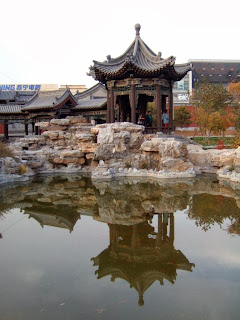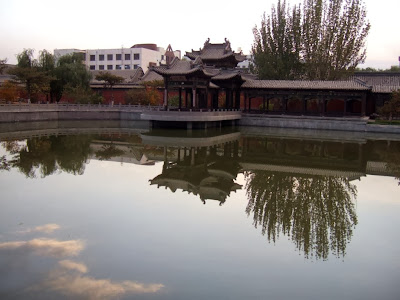
Temple Shanhua-si (善化寺) is one of the major historical and cultural sites in Datong City, covering a land area of 13900 sq meter. It is commonly known as South Temple (南寺) as it situated at Yongtai Street by the west side of South Street. The temple was first found in Tang Dynasty (618-907) and was named as Kaiyuan-si (开元寺) during the reign of Emperor Xuanzong (玄宗 713-741). The name was changed to Temple Dapuen-si (大普恩寺) in late Jin Dynasty of 5-Empires period (五代后晋 936-947). Within this chaotic period, many of its structures were destroyed. After the founding of Liao Dynasty (907-1125), the temple managed to assume to its configuration. In year 1120-1122, it was again heavily damaged at war. The monastery was restored 6 years later by its Abbot Master Manyuan (满圆大师), after the reign of Liao era was over, and kingdom fell in the hand of subsequent Nuzhen Jin Dynasty (金 1120-1234). The restoration project took 15 years (1128-1143) to complete. As recorded in Yuan history, it could accommodate as many as 40,000 monks who under an imperial order of Kublai-khan, had assembled here for some Buddhist Activity. Another major repair work of the temple took place in year 1442-1445 during Ming Dynasty, executed by Monk Dayong and the name as referred in an imperial presentation of Sutras was amended to Shanhua-si as used until today.



Lined up along the north south axis of the Temple Complex, are Lokapala Hall, Three Sages Hall and Maha Vihara Hall with Pavilion of Puxian-ge and Wenshu-ge standing in front. Most of the Halls were first built in Liao Dynasty (906-1125)and went through extensive renovation in Jin Dynasty (1120-1234). The only structure that had escaped from destruction at war was Maha Vihara Main Shrine Hall which was considered the only Liao built original structure presently. Being the largest hall at site, it sits on a stone platform of 3.3 meter high, with Bell and Drum Towers on two sides.


Pavilion Puxian-ge, a 2-storey square structure with wooden stairs inside leading to the top for outside view, was first built in year 1154 in Jin Dynasty. It enshrines an image of Bodhisattva Samantabhadra. Pavilion Puxian-ge and Wenshu-ge are two exclusive buildings standing in front of Maha Vihara Hall. The Wenshu-ge enshrines an image of Bodhisattva Manjushri was a newly rebuilt structure as it was burnt down by fire after being converted into a tannery in early 20th century.



The Liao built original structure of Pavilion Puxian-ge was destroyed in World War II and rebuilt in year 1953.


The Chinese garden by west side of Shanhua-si is tradition and beautiful.


A spectacular view of garden lake with reflection of Maha Vihara Main Shrine Hall on it.



Remarkable garden sight.




The gorgeous little pavilions at corners are ideal place for meditation or simply a rest of mind.


It is an olden setup of gardens, with lake, stone, decorative pavilions and winding corridors.


A dynamic water reflected sight of 11-12th century temple buildings.


Amazing sight!


Fantastic scenic view!



Immersed in its serenity



Lovely pavilions are linked up by long corridors.









Clouds were captured inside the water.



Long corridors and little pavilions at the garden site are really impressive.




The Chinese tradition corridors that encircle a lake of crystal clear water.


Lonely but peaceful


Decorative corridors






Lokapala Hall that enshrines 4 heavenly kings is behind The arch gate. Both of the structures and Main Shrine Hall were first constructed in Liao Dynasty. The Main Shrine Hall is considered as a Liao building but The Arch Gate, Lokapala Halls and Three Sages Hall buildings are classified as Jin's structure as they undertook too extensive renovation in Jin Dynasty.



Main Shrine Hall enshrines five adorable gold-gilded Buddha images for five directions with Buddha Vairocana seated at the center. All of them are the original product from Yuan Dynasty. The 24 life-like sculptures of heavenly Gods, displayed at the side brick altar are vivid in character.



Murals depicting the Buddhist legends dated back to 17th century during the reign of Emperor Kangxi in Qing Dynasty (1644-1911), on both walls of the Main Shrine Hall are interesting.




Hall of Three Avatamsaka Sages enshrined with Images of Buddha Vairocana and Bodhisattva Manjushri and Samantabhadra at the front altar, was a 12th century building. It was first built in Liao but restored in Jin Dynasty.




With a strike of red by these little lovely twirling maple leaves, the surrounding became lively.



Datong City has few such kind of ancient dragon screens, among which screen of nine dragons and five dragons are most popular and beautiful.


The five dragon screen stands in front of Shanhua-si is rich in color especially when it was under the shine of sunset beam-light.


Leaving Shanhua-si in dusk.


No comments:
Post a Comment